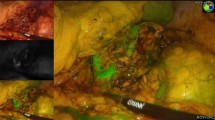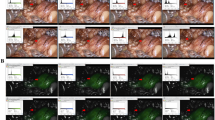Abstract
Background
To investigate the feasibility of a method for intraoperative tumor localization and tissue distinction during robotic adrenalectomy (RA) via indocyanine green (ICG) imaging under near-infrared light.
Methods
Ten patients underwent RA. After exposure of the retroperitoneal space, but before adrenal dissection was started, ICG was given intravenously (IV). Fluorescence Firefly™ imaging was performed at 1-, 5-, 10-, and 20-min time points. The precision with which the borders of the adrenal tissue were distinguished with ICG imaging was compared to that with the conventional robotic view. The number and the total volume of injections for each patient were recorded.
Results
There were six male and four female patients. Diagnosis was primary hyperaldosteronism in four patients and myelolipoma, adrenocortical neoplasm, adrenocortical hyperplasia, Cushing’s syndrome, pheochromocytoma, and metastasis in one patient each. Procedures were done through a robotic lateral transabdominal approach in nine and through a robotic posterior retroperitoneal approach in one patient. Dose per injection ranged between 2.5 and 6.3 mg and total dose per patient 7.5–18.8 mg. The adrenal gland took up the dye in 1 min, with contrast between adrenal mass and surrounding retroperitoneal fat becoming most distinguished at 5 min. Fluorescence of adrenal tissue lasted up to 20 min after injection. Overall, ICG imaging was felt to help with the conduct of operation in 8 out of 10 procedures. There were no conversions to open or morbidity. There were no immediate or delayed adverse effects attributable to IV ICG administration.
Conclusion
In this pilot study, we demonstrated the feasibility and safety of ICG imaging in a small group of patients undergoing RA. We described a method that enabled an effective fluorescence imaging to localize the adrenal glands and guide dissection. Future research is necessary to study how this imaging affects perioperative outcomes.




Similar content being viewed by others
References
Taskin HE, Berber E (2013) Robotic adrenalectomy. Cancer J 19(2):162–166
Agcaoglu O, Aliyev S, Karabulut K, Mitchell J, Siperstein A, Berber E (2012) Robotic versus laparoscopic resection of large adrenal tumors. Ann Surg Oncol 19(7):2288–2294
Agcaoglu O, Aliyev S, Karabulut K, Siperstein A, Berber E (2012) Robotic vs laparoscopic posterior retroperitoneal adrenalectomy. Arch Surg 147(3):272–275
Aksoy E, Taskin HE, Aliyev S, Mitchell J, Siperstein A, Berber E (2013) Robotic versus laparoscopic adrenalectomy in obese patients. Surg Endosc 27(4):1233–1236
Giulianotti PC, Buchs NC, Addep P, Bianco FM, Ayloo SM, Caravaglios G, Coratti A (2011) Robot-assisted adrenalectomy: a technical option for the surgeon? Int J Med Robot Comput Assist Surg 7:27–32
Brunaud L, Ayav A, Zarnegar R, Rouers A, Klein M, Boissel P, Bresler L (2008) Prospective evaluation of 100 robotic-assisted unilateral adrenalectomies. Surgery 144(6):995–1001
Alander JT, Kaartinen I, Laakso A, Pätilä T, Spillmann T, Tuchin VV, Venermo M, Välisuo P (2012) A review of indocyanine green fluorescent imaging in surgery. Int J Biomed Imaging. doi:10.1155/2012/940585
Daskalaki D, Fernandes E, Wang X, Bianco FM, Elli EF, Ayloo S, Masrur M, Milone L, Giulianotti PC (2014) Indocyanine green (ICG) fluorescent cholangiography during robotic cholecystectomy: results of 184 consecutive cases in a single institution. Surg Innov 21(6):615–621
Boni L, David G, Mangano A, Dionigi G, Rausei S, Spampatti S, Cassinotti E, Fingerhut A (2014) Clinical applications of indocyanine green (ICG) enhanced fluorescence in laparoscopic surgery. Surg Endosc. doi:10.1007/s00464-014-3895-x
Manny TB, Pompeo AS, Hemal AK (2013) Robotic partial adrenalectomy using indocyanine green dye with near-infrared imaging: the initial clinical experience. Urology 82(3):738–742
Zeiger MA, Thompson GB, Duh QY, Hamrahian AH, Angelos P, Elaraj D, Fishman E, Kharlip J, American Association of Clinical Endocrinologists, American Association of Endocrine Surgeons (2009) American Association of Clinical Endocrinologists and American Association of Endocrine Surgeons Medical Guidelines for the Management of Adrenal Incidentalomas: executive summary of recommendations. Endocr Pract 15(5):450–453
Speich R, Saesseli B, Hoffmann U, Neftel KA, Reichen J (1988) Anaphylactoid reactions after indocyanine-green administration. Ann Intern Med 109(4):345–346
Disclosures
Authors Sara Sound, Alexis K. Okoh, Hakan Yigitbas, Cem Dural, and Eren Berber have no conflict of interest or financial ties to disclose.
Author information
Authors and Affiliations
Corresponding author
Rights and permissions
About this article
Cite this article
Sound, S., Okoh, A.K., Bucak, E. et al. Intraoperative tumor localization and tissue distinction during robotic adrenalectomy using indocyanine green fluorescence imaging: a feasibility study. Surg Endosc 30, 657–662 (2016). https://doi.org/10.1007/s00464-015-4256-0
Received:
Accepted:
Published:
Issue Date:
DOI: https://doi.org/10.1007/s00464-015-4256-0




